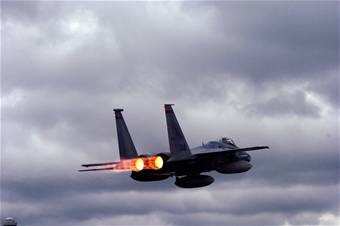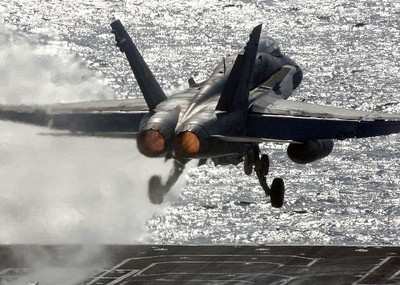Mon, Nov 19, 2012
Both Aircraft Are Now Equipped To Participate In Live, Virtual And Constructive Training Simulations
Two military aircraft produced by Boeing ... the F-15E Eagle and the F/A-18E Super Hornet ... now are equipped to train in an environment that puts them at odds against real aircraft and computer-generated enemy threats at the same time. Under a $6.3 million, three-year contract with the U.S. Air Force Research Laboratory, Boeing is developing these simulation capabilities for both the U.S. Air Force F-15E and the U.S. Navy F/A-18E/F. Under the current contract, the pilot project will culminate with a capstone demonstration at Nellis Air Force Base in Nevada in late 2013.

This technology can provide aircrews with a complex virtual strike environment in which to train, while potentially decreasing the number of real aircraft and other assets to practice against. Generally, an actual combat aircraft (live) is networked with ground-based simulation computers (virtual) that provide computer-generated threats (constructive). Before this new capability, pilots could practice using flight simulators on the ground, but when they trained in the actual aircraft, other people were needed to play the role of an opponent, commonly referred to as a "red" or adversary team.
Having a virtual combat simulation while actually flying is expected to reduce the number of real aircraft or other live assets needed to form a red team, providing cost-savings and a safer training environment. Anticipating the future needs of both the U.S. Navy and U.S. Air Force, Boeing began developing this modeling and simulation technology on its own in 2007, which reduced the government's risk in exploring the capability. A series of demonstrations with an F-15E through November 2009 verified key components. And a Super Hornet recently completed its first flight tests to evaluate these new technologies. "It's exciting to see the technology grow and mature across multiple platforms while supporting the U.S. Navy's vision," said Rob Lechner, pilot project manager and a chief engineer in Boeing Research & Technology.

During the most recent flight tests, two F/A-18Es and two F-15Es simulated air combat between two live F-16s and 12 virtual aircraft, as well as multiple ground threats. A 40/45 Airborne Early Warning and Control System (AWACS) surrogate provided command and control for the exercise. "The integrated training environment can generate warfighter readiness and make aviation flight training much more effective," said John Schwering, Boeing business development leader for integrated Live, Virtual and Constructive training. "Training can be significantly enhanced by increasing the overall threat density with the use of more sophisticated constructive adversary aircraft and ground-based electronic warfare threats."
(Pictured Top: F-15E Eagle, Bottom: F/A-18 Super Hornet)
More News
Aero Linx: Model Aeronautical Association of Australia MAAA clubs are about fun flying, camaraderie and community. For over 75 years, the MAAA has been Australia’s largest fl>[...]
Touchdown Zone Lighting Two rows of transverse light bars located symmetrically about the runway centerline normally at 100 foot intervals. The basic system extends 3,000 feet alon>[...]
“Discovery and innovation are central to our mission at Virgin Galactic. We’re excited to build on our successful record of facilitating scientific experiments in subor>[...]
How To Get A Story On Aero-TV News/Feature Programming How do I submit a story idea or lead to Aero-TV? If you would like to submit a story idea or lead, please contact Jim Campbel>[...]
Student Pilot Reported That During Rotation, “All Of A Sudden The Back Of The Plane Kicked To The Right..." Analysis: The student pilot reported that during rotation, “>[...]
 ANN's Daily Aero-Linx (05.02.24)
ANN's Daily Aero-Linx (05.02.24) ANN's Daily Aero-Term (05.02.24): Touchdown Zone Lighting
ANN's Daily Aero-Term (05.02.24): Touchdown Zone Lighting Aero-News: Quote of the Day (05.02.24)
Aero-News: Quote of the Day (05.02.24) ANN FAQ: Contributing To Aero-TV
ANN FAQ: Contributing To Aero-TV NTSB Final Report: Cirrus Design Corp SR20
NTSB Final Report: Cirrus Design Corp SR20




